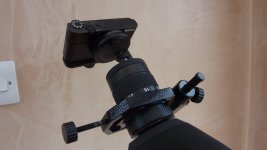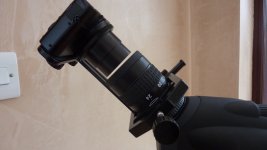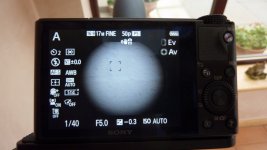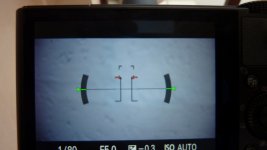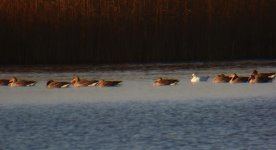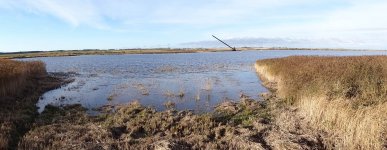I'd be interested to hear thoughts on this comparisson too. My J1 has started playing up (only a couple of months old) and is already on it's second visit to Nikon. Hopefully this time they will bother sorting it out this time rather than just returning it with a generic checked and cleaned note!
I have been toying with replacing my P300 with a RX100 but haven't done so yet, if it could also replace the J1 as a primary digiscoping camera I think I'd go for it. To be honest I'd quite happily not see the J1 again as it has caused me to much hassle, just need to get it repaired (or hopefully replaced) so that I can sell it.
Sorry to hear about your J1 problems.
The comparison is now impacted by the announcement of the Nikon V2. The new 18.5/1.8 lens for the V2 might be step up from the zooms. I've always preferred to zoom an eyepiece than zoom a lens too far.
For the V1 against the RX100 -
Nikon V1
Pros - Electronic Viewfinder
- screw thread in lens for adapter ( 40.5 mm )
- high speed frames per second ( 5/10/20/60 ) with Raw
- silent in Electronic Mode.
- easily selectable HD Video Mode with separate settings to stills
- IR Remote Control
- bulit in ND Filter for Video
- excellent battery life (same battery as D7000 and D800)
- huge buffer means that you can continue shooting
- and of course ability to use other legacy lenses with the FT1 adapter
Negs
- no rotatable screen
- only 10 megs
- overheats in summer in Video Mode after about 10 mins
- only 5x digital crop for MF
Sony RX100
Pros - very sharp Carl Zeiss lens to full zoom ( f1.8 ) 28 -100 mm
- little vignetting with zoom and fixed eyepieces ( using Universal Adpt)
- 20 megs good for cropping
- large sensor gives excellent quality
- fits in a pocket so always with you
- Sweep Panorama Mode ( stitched in-camera)
- hi quality HD Video ( 60/50 fps at 24 megs/sec )
- 3 shot Self-timer Mode ( V1 only 1 shot )
Negs
- no Remote Control
- no rotatable screen
- no Electronic Viewfinder ( I digiscope 90% from hides so not as much of a problem as out in the sunshine)
- shorter battery life.
- buttons are a bit fiddly and hard to see in the darkness of the hide
Overall I would give the RX100 9/10 for image quality, 8/10 for Operation and 8/10 for other functions.
The V1 8/10 image quality ( less difference at under 30 meters ),9/10 for operation and 7/10 for other functions ( no Sweep Panorama which I like a lot)
The new V2 should narrow the gap in image quality so the ability to use a Remote and screw thread for adapters will swing the vote back in it's favor.
You will improve your digiscoping with both cameras though.
Hope this helps a bit.
Neil
Hong Kong,
China.
Oct 201




